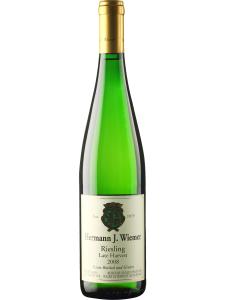The Finger Lakes region of upstate New York is one of the eastern United States' finest wine-growing areas. This cool-climate zone is known particularly for its high-quality Riesling, which is produced in both dry and sweeter styles, and even as lusciously sweet ice wine.
With its short growing season and icy winters, the Finger Lakes area has much in common with the key winegrowing regions of Germany. It is no coincidence that Riesling (the quintessential German wine grape) is by far the most successful and widely planted variety in Finger Lakes vineyards. The classic dry Finger Lakes Riesling is characterized by refreshing acidity and aromas of citrus, apple and chalky minerality.
In addition to Riesling, various other cool-climate varieties – notably Chardonnay, Pinot Noir and Cabernet Franc – are widely planted here. These typically produce light, tart wines, quite different in style from their Californian equivalents. Moderate alcohol levels are a common feature in these (and all) Finger Lakes wines, as is to be expected from such a cool region.
Warmer-climate varieties such as Syrah and Cabernet Sauvignon are also found here, but reach acceptable ripeness levels only the very warmest, sunniest vineyard sites. Perhaps the most unusual variety here, grown by just a few wineries, is Eastern European white-wine specialty Rkatsiteli.
The Vitis vinifera varieties discussed above are responsible for the Finger Lakes' highest-quality wines, but the native American grape species are also represented here. The most obvious example is Concord (the flagship variety of the Vitis labrusca species), which is grown not just in New York, but all over the northeastern United States. Various cold-resistant, French-American hybrids are also grown in the region's vineyards, most saliently the white-wine varieties Niagara and Cayuga, whose names are a reminder that they were bred right here in New York state. Vidal, a hybrid particularly popular in Canada, is used here mostly for sweet wines (mostly late-harvest and ice wines).
The lakes themselves (whose name echoes their finger-like shape) are vital to the region's wine industry. Without their temperature-moderating influences, the climate would be just too cold and continental to support quality viticulture. Vineyards planted near the lakes benefit from both moderated temperatures and increased air movement, which combine to reduce the risk of frost damage in spring and autumn. The lakes also release stored heat during the winter, making the temperatures milder than in outlying areas. Most vines are planted on the steep slopes that surround the lakes, enabling cold air to drain away more easily. Soils are generally glacial, deep and free-draining.
In spite of the lakes' climate-moderating influence, the particularly harsh winter of 2013/2014 saw widespread damage in vineyards throughout the AVA. Months of sub-zero temperatures as low as -18F (-28C) damaged almost 50 percent of the region’s Riesling, Gewurztraminer, Sauvignon Blanc, Chardonnay and Cabernet Franc vines.
The official Finger Lakes viticultural area (see AVA) was drawn up in 1982. It covers a vast area of 2.6 million acres (1,052,183ha) of which roughly 11,000 acres (4,452 ha) are planted to vines. making the Finger Lakes by far the largest and most productive wine region in New York State. Roughly 80 percent of New York State's total wine production comes from Finger Lakes vineyards.
There are 11 Finger Lakes in all, carved out by the movement of glaciers during the ice age. Iroquois tribal legends proclaim them to be the fingers of the Great Spirit. The lakes all have Native American names such as Cayuga (Boat Landing), Seneca (Stony Place), Keuka (Crooked Lake). Cayuga and Seneca were officially recognized as independent AVAs in 1988 and 2003 respectively.


